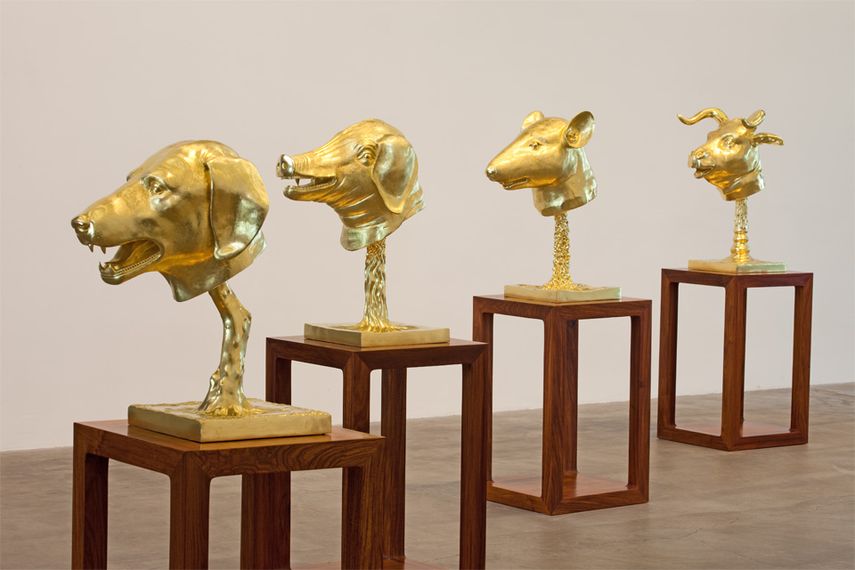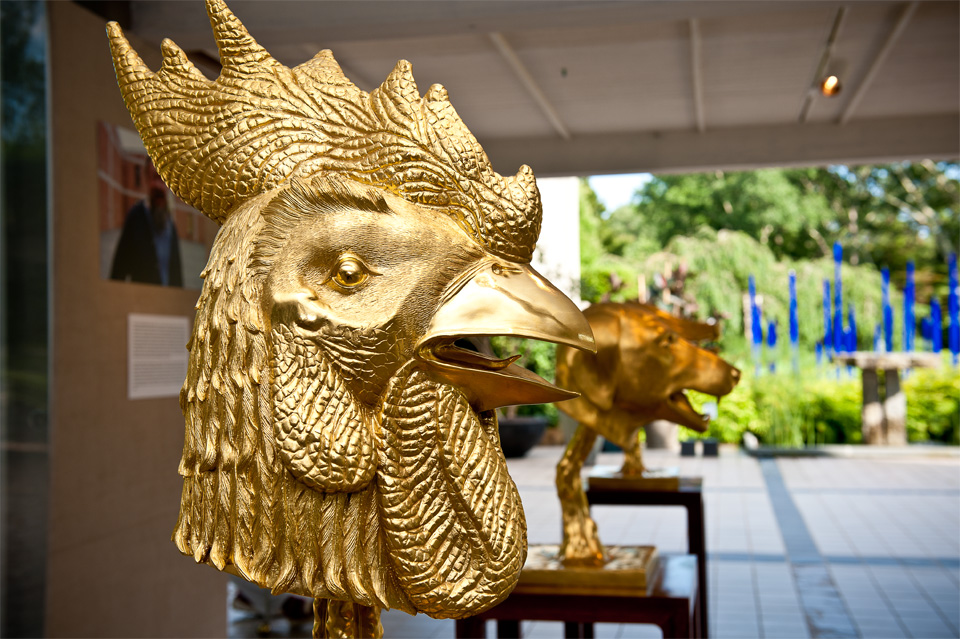[ad_1]
Famed for his tongue-in-cheek criticism and battles with Chinese state, the contemporary artist and activist Ai Weiwei creates works that are a conflation of art and politics. Through his practice, he tirelessly works to expand the definition of art to include new forms of social engagement.
His installation Circle of Animals / Zodiac Heads is the centerpiece of a global, multi-year touring exhibition that has been presented in the United States, Europe and Asia. It is comprised of twelve ornate, gilded animal heads, each depicting a segment of the ancient Chinese zodiac – rat, ox, tiger, rabbit, dragon, snake, horse, sheep, monkey, rooster, dog and pig. These lavish objects sit atop custom-made wooden pedestal also constructed by the artist.
Like virtually all of Ai Weiwei’s art, there is much more going on with these striking pieces than it first appears. Conceived by a courageous artist who is never afraid to ask inconvenient questions, it is actually a work that deals with issues of theft and appropriation, at the same time telling a story about the freedom of imagination and the persistence of ideas. In this piece, the dual strands of art and politics the artist has been acclaimed for, reach back more than 150 years.
Ai Weiwei – Circle of Animals / Zodiac Heads
Looking Into the Past
The origins and motivation behind the Circle of Animals / Zodiac Heads are as compelling as the work itself. In his first major public sculpture project, Ai Weiwei reinterpreted twelve zodiac animal heads designed in the 18th century by two European Jesuits in the court of the Qing dynasty Emperor Qianlong. These sculptures once adorned the famed and complex fountain-clock of the Yuanming Yuan, a magnificent imperial retreat in Beijing.
In 1860 during the Second Opium War, the British diplomat James Bruce ordered the complete destruction of the imperial complex as a retaliatory gesture. As the fires raged, he and his troops looted considerable treasure, including the zodiac heads. To this day, only five have been brought back to China, out of seven that have resurfaced.
Ai Weiwei’s project was a response to the controversy that erupted when two heads – a rat and a rabbit – resurfaced at Christie’s Paris auction of the Yves Saint Laurent estate in 2009. Bidder Cia Mingchao, a member of China’s “Lost Cultural Relics Foundation”, won the pair for nearly $40 million, then refused to pay, removing the pieces at least temporarily from the international market.
Cast in bronze and coated with gold patina, Ai’s pieces measure just under 30 inches each in height, approximating the size of their bronze antecedents. With these works, the artist asks a tangle of unpleasant cultural, moral and aesthetic questions.

The Original and the Copy Explored in Weiwei Sculpture Works
By reimagining these cultural objects, Ai Weiwei confronts uncomfortable truths within Chinese and Western history. He focuses on the questions concerning looting and reparation, at the same time exploring notions of the fake and the copy in relation to the original, but also what constitutes these categories.
Since only seven zodiac heads have been recovered, the artist had to use his imagination and reconstitute the missing ones to his own liking. Circle of Animals / Zodiac Heads displays some striking stylistic discontinuities – while the sheep is almost naturalistic, the monkey has a streamlined brow and stylized round eyes and the dragon is instantly identifiable as the characteristic fantasy animal of ancient China.
It was important for the artist to complete the zodiac set, and more importantly, to complete it the way he thought it should be. As he adds, the work relates to some very complicated issues:
Who made [the original fountain clock], for what reason? And why were the heads lost? Are they truly lost, or at the auction house? Who is buying and for what reason? [One of the missing zodiac heads] may just show up next season, so we will see how it compares [to our version of it]. You try to imagine the existing zodiac image, but your imagination can’t really “meet” the real one.
The work of Ai Weiwei always deals with the notions of real or fake, authenticity and value, and how this value relates to current political and social understandings and misunderstandings. By remaking decorative objects that were a functioning part of the fountain into a piece of conceptual art, the artist questions the whole idea of the identity and the originality of the work.
It’s pointing to many different issues—of course to China, to myself, to all the people who would question whether the work is valuable or not valuable, real or not real, or better than real, or not as good as real.

Where to See Ai Weiwei’s Circle of Animals / Zodiac Heads
On tour since 2011, Ai Weiwei’s work has already visited fourteen museums and galleries all around the world. The official world tour for Circle of Animals / Zodiac Heads was launched in New York City at the historic Pulitzer Fountain at Grand Army Plaza in May 2011.
The gold series is currently on view at Arken Museum of Modern Art in Skovvej, Denmark until July 2019 and it will be on view at Farnsworth Art Museum in Rockland, Maine from March 24th and December 30th, 2018.
The bronze series of zodiac animal heads is currently on view at Yorkshire Sculpture Park in West Bretton, England until May 18th, 2018, at The John & Mable Ringling Museum of Art in Sarasota, Florida until June 2nd, 2018, at Jordan Schnitzer Museum of Art in Eugene, Oregon until June 24th, 2018 and at the Voorhies Memorial Fountain at Civic Center Park in Denver, Colorado until October 17th, 2018.
The exhibition is accompanied by a publication Ai Weiwei, Circle of Animals / Zodiac Heads edited by Susan Delson that tells the riveting story behind a highly acclaimed piece of contemporary art, while providing an introduction to one of our generation’s most important artists.
Editors’ Tip: Ai Weiwei: Circle of Animals Hardcover by Susan Delson
From its fascinating historical origins to its contemporary symbolic significance, every aspect of Ai Weiwei’s beautiful and monumental work of art is explored in this illustrated volume that also guides readers through the highlights of the artist’s career. Ai Weiwei’s Circle of Animals/Zodiac Heads reinterpret twelve large-scale bronze animal heads that were part of a complex zodiac fountain that was built for an imperial retreat in eighteenth-century China. This book compares Ai Weiwei’s work to the original zodiac heads; features interviews with Ai Weiwei conducted at various periods during the sculpture’s development; offers a historical overview of the events surrounding the mountain’s looting; and follows the trail of the original heads as they are sold and resold amidst political furor. The book tells the riveting story behind a highly acclaimed piece of modern art, while providing an introduction to one of our generation’s most important artists.
Featured image: Zodiac Heads, Arken Museum of Modern Art, Skovvej, Denmark; Zodiac Heads, The Zoo Exhibition, Musée d’art contemporain de Montréal, Canada; Left: Zodiac Heads, Snake / Right: Zodiac Heads, Tiger; Left: Zodiac Heads, Rooster / Right: Zodiac Heads, Snake; Left: Zodiac Heads, Rabbit / Right: Zodiac Heads, Ram; Left: Zodiac Heads, Horse / Right: Zodiac Heads, Monkey; Left: Zodiac Heads, Dog / Right: Zodiac Heads, Dragon; Left: Zodiac Heads, Ox / Right: Zodiac Heads, Pig. Images via zodiacheads.com; courtesy Heather James Fine Art.
[ad_2]
Source link
